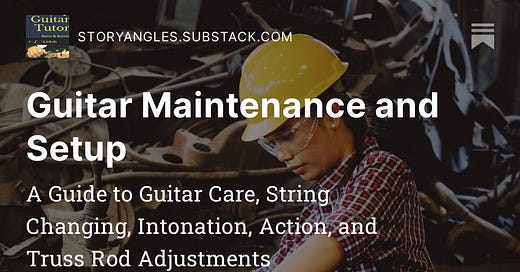Guitar Maintenance and Setup
A Guide to Guitar Care, String Changing, Intonation, Action, and Truss Rod Adjustments
Introduction
Proper guitar maintenance and setup are essential for ensuring optimal playability, sound quality, and longevity of your instrument. This comprehensive guide aims to provide you with a detailed understanding of guitar care, including maintenance tips, cleaning techniques, and step-by-step instructions for common setup adjustments. You will learn about string changing, intonation, action, and truss rod adjustments, empowering you to keep your guitar in excellent condition and maximize its performance.
Guitar Maintenance and Care
Learn the best practices for maintaining your guitar. This includes regular cleaning, polishing, and protecting the guitar's finish. Understand the importance of maintaining stable humidity and temperature conditions to prevent damage and wood warping. Discover effective techniques for cleaning the fretboard, frets, and hardware, as well as general guitar maintenance tips for maintaining optimal performance.
String Changing
Explore the process of changing guitar strings correctly. Learn about different types of strings, string gauges, and how to select the right set for your playing style. Follow step-by-step instructions for safely removing and replacing strings, properly winding them around the tuning pegs, and tuning your guitar accurately. Understand the importance of regularly changing strings to maintain tonal clarity and playability.
Intonation Adjustment
Intonation refers to the accurate pitch of each string when played at different positions on the fretboard. Discover how to adjust the intonation of your guitar to ensure that it plays in tune across the entire neck. Learn about tools such as electronic tuners and how to use them to achieve precise intonation. Follow the process of adjusting saddle positions and fine-tuning each string's intonation for optimal performance.
Action Adjustment
The action of a guitar refers to the distance between the strings and the fretboard. Explore how to adjust the action to suit your playing preferences. Learn about common action-related issues such as fret buzz and high action, and how to diagnose and resolve them. Discover the proper techniques for adjusting the bridge or saddle height to achieve the desired action and optimize playability.
Truss Rod Adjustments
The truss rod is a metal rod inside the neck of the guitar that helps counteract the tension created by the strings. Understand the role of the truss rod in maintaining neck relief and addressing issues such as bowing or backbowing. Learn how to identify the signs that a truss rod adjustment is necessary and follow step-by-step instructions for making proper truss rod adjustments. Discover the importance of making gradual adjustments and seeking professional assistance if needed.
Conclusion
Taking care of your guitar through proper maintenance and setup is crucial for preserving its condition and optimizing its performance. By following the tips and techniques outlined in this comprehensive guide, you can confidently handle tasks such as string changing, intonation adjustments, action adjustments, and truss rod adjustments. Remember to approach these tasks with care, seek professional help when needed, and enjoy the rewarding experience of maintaining your guitar in top-notch condition.
Keep reading with a 7-day free trial
Subscribe to My Guitar Tutor Online to keep reading this post and get 7 days of free access to the full post archives.




